
Atlantic Models 1:350 HMS Arrow
| KIT #: | ATK 35011 |
| PRICE: | Ģ123.95 plus shipping |
| DECALS: | Yes |
| REVIEWER: | Frank Spahr |
| NOTES: | Resin with metal and wire parts |

| HISTORY |
The Type 21
In 1964, the Royal Navy looked for a new general purpose frigate to replace the Leopard and Salisbury class ships. The new ship should be affordable to be built in larger numbers, and it was also aimed at the export market to generate work for British yards. For a while, there were plans to develop a common type with the Royal Australian Navy, but these did not come to fruition. The heavy workload of the navyīs ship design bureau at Bath and lobbying by the private yards of Vosper Thornycroft and Yarrow resulted in the new class being designed entirely by said private yards. This had not happened in a long time, and it was advertised as being a lot cheaper and more effective.
Originally, four vessels were ordered, but the order was doubled to eight vessels of what was known as the type 21 frigate or the Amazon class. The ships were handsome and looked very sleek. Their gas turbine propulsion cut manpower and provided motive power without waiting for boilers to raise steam. Use of marinized aluminium in their superstructures saved a lot of weight. Officer accommodation was superior to previous standards. The ships were very fast, even though sources differ here. Small wonder they were nicknamed the "Porsches" in the fleet.
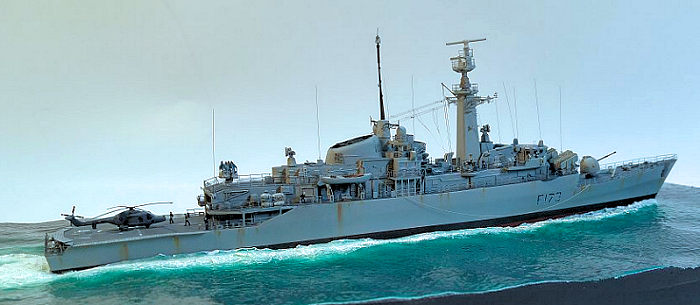 On the
downside, they ended up much more expensive than originally advertised. Their
armament was rather limited; they fielded the new automatic 4.5 in Mk. VIII gun,
two 20 mm Oerlikons, a quadruple launcher for the already obsolescent Seacat
missile, plus a light helicopter. Later on, four Exocet anti-ship missiles were
retrofitted, and two triple lightweight torpedo tubes. The radar and electronics
fit was rather limited, too, and especially lacked the then standard type 956
long range radar. Contrasting with official designs, there was hardly any
reserve for equipment upgrades. The gas turbine installation was much lighter
than previous powerplants, so topweight needed to be limited to prevent the
ships from becoming top-heavy. This influenced the radar and ESM fit and also
other equipment upgrades.
On the
downside, they ended up much more expensive than originally advertised. Their
armament was rather limited; they fielded the new automatic 4.5 in Mk. VIII gun,
two 20 mm Oerlikons, a quadruple launcher for the already obsolescent Seacat
missile, plus a light helicopter. Later on, four Exocet anti-ship missiles were
retrofitted, and two triple lightweight torpedo tubes. The radar and electronics
fit was rather limited, too, and especially lacked the then standard type 956
long range radar. Contrasting with official designs, there was hardly any
reserve for equipment upgrades. The gas turbine installation was much lighter
than previous powerplants, so topweight needed to be limited to prevent the
ships from becoming top-heavy. This influenced the radar and ESM fit and also
other equipment upgrades.
When the ships entered service, concerns rose about the aluminium superstructure. Its resistance (or lack thereof) to higher temperatures in a fire, the danger of it splintering upon being hit by gunfire, but also the risk of cracks developing between the steel hull and the aluminium superstructure caused worries. In fact, when the Type 21s were deployed into the South Atlantic in 1982, the commanding officers were ordered to avoid excessive motions. That proved to be impossible fighting a war in the areaīs harsh climate. Several vessels needed emergency repairs for cracks in their hulls, and all of the survivors received longitudinal external bracing later on.
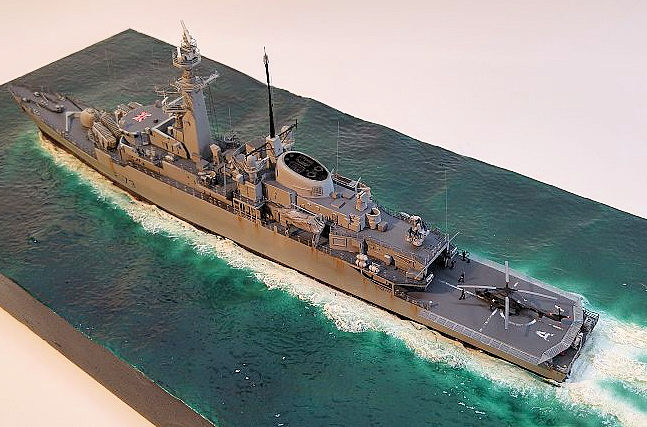 All of the
class served during the Falklands campaign of 1982; Amazon was the only one to
arrive after the Argentine surrender. Two of the class were lost to enemy fire.
Ardent was strafed and bombed repeatedly by flights of aircraft on the 23rd May
and sunk. Antelope received bomb hits which failed to explode, but one was set
off by the disposal team attempting to defuse it. The resulting fire set off the
shipīs magazines, breaking her back and sinking her.
All of the
class served during the Falklands campaign of 1982; Amazon was the only one to
arrive after the Argentine surrender. Two of the class were lost to enemy fire.
Ardent was strafed and bombed repeatedly by flights of aircraft on the 23rd May
and sunk. Antelope received bomb hits which failed to explode, but one was set
off by the disposal team attempting to defuse it. The resulting fire set off the
shipīs magazines, breaking her back and sinking her.
After the war, further equipment upgrades for use as ASW vessels was considered. Crucial components would be a powerful sonar system, and the modern Seawolf missile system for self-defence. Several of the older Leander class frigates were modified in this manner, but the Type 21 lacked the necessary growth reserve to install both, so was left alone.
In the end, the vessels did not generate the desired export sales, they ended up more expensive, less capable and lacking in potential for modernization than the previous official design. In 1994, the Navy sold the six survivors to Pakistan, where four of them still serve today.
The Ship
HMS Arrow was built by Yarrow Shipbuilders Ltd, Glasgow and launched on 5th
February 1974 by Lady Raper, wife of Vice Admiral Sir George Raper, Arrow was
the fifth Type 21 Frigate to be built and the fi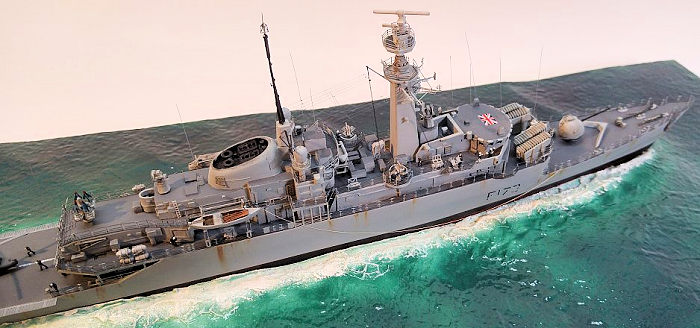 rst
to carry Exocet missiles. She was commissioned on 29th July 1976 in Sunderland,
the town to which she was affiliated.
rst
to carry Exocet missiles. She was commissioned on 29th July 1976 in Sunderland,
the town to which she was affiliated.
HMS Arrow served along with all her sister ships that made up the 4th Frigate squadron, during the Falklands campaign in 1982, and was in the first wave of ships deployed. She claimed the distinction of being the first ship to fire on the Argentine shore positions as well as the first ship to be hit by enemy fire after being strafed by a fighter jet.
She went alongside HMS Sheffield after the missile attack which disabled her, and helped to take off the survivors. Her aluminium superstructure suffered in the process, and she needed emergency repairs. She operated in and around Falkland sound with HMS Alacrity, keeping the seaway open and providing gunfire support to the troops ashore.
After Arrow returned home she went into refit until September 83, after which she headed back to the Falklands as guardship. She also spent time in the West Indies as guardship and carried out anti piracy patrols. HMS Arrow served in the fleet until 1994 after which she was decommissioned and sold to the Pakistan Navy and renamed PNS Khaibar. She remains in service to this day in the Pakistan Navy .
| THE KIT |
This
resin kit is what you have come to expect from Peter Hall, formerly working for
White Ensign Models, and now for his own company Atlantic Models. You get neatly
produced and rather well-fitting resin parts, a full panoply of very neat PE
parts, a number of white metal parts, some metal rods, a decal sheet covering
all vessels of the class, and comprehensive and well-thought-out instructions.
The white metal parts are coarser and need more cleanup than the resin parts,
but used where resin would not work for
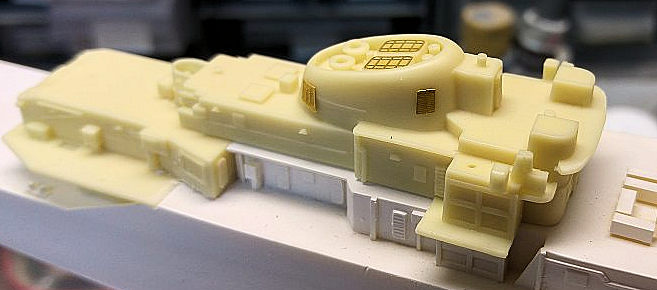 casting
or weight reasons.
casting
or weight reasons.
The kit is usable virtually for all the ships in class. The limited scope of modernization made it possible to include both a Wasp and Lynx helo, plus parts for the early and late main mast, plus the early and late torpedo deck supports. For an early fit, the Exocet launchers would have to be deleted and the Corvus flare launchers moved ahead of the bridge. Some items are included in the PE fret, but not mentioned in the instructions, such as signal lights for the bridge wings and danbuoys.
A machined brass gun barrel, produced by Master of Poland, is available via Atlantic Models. I used this gun barrel plus the very neat Oerlikons from Master, as they are superior to the all-PE assemblies from the kit.
| CONSTRUCTION |
Having just completed another Atlantic Models resin kit, I was reasonably familiar with the process. The type 21 being a smaller and much simpler vessel, it was an easier build. I especially approved of the lack of any complicated latticework PE assembly in the radar or missile launcher department. Both parts had taxed my skills and especially patience in the HMS Glamorgan build.
Deciding to model Arrow during her Falklands service, I made sure about
her fit. She had the early main
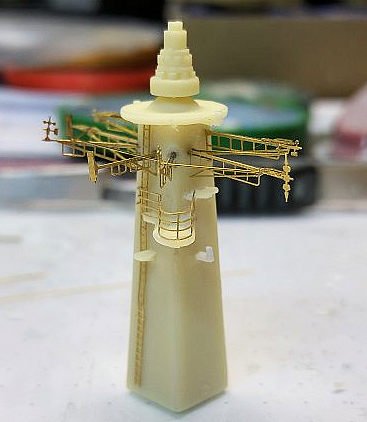 mast
then, the Lynx helo, and no torpedo tubes yet. I found a nice photo of her
returning home after the war to reference her fit as well as markings and wear
and tear.
mast
then, the Lynx helo, and no torpedo tubes yet. I found a nice photo of her
returning home after the war to reference her fit as well as markings and wear
and tear.
After cleaning up the resin parts, I assembled the hull parts with liberal amounts of CA glue. Sanding the hull seams was a bit more of an effort than with the County Class, but easily done. Parallel to that, I identified the various subassemblies (again, a much shorter list than with Glamorgan) and set to work on them. I made sure I used the machined brass barrel with the gun, and it worked well. The two kit all-PE Oerlikons were substituted with Masterīs superior items combining PE and machined brass.
I digressed from the kit instructions in only a few places. I chose to
replace resin part 9, the Fore Mast radar platform, with the PE underpanels and
scratchbuilt the rest of the part instead of grinding away from it to use the PE
panels with the kit part. The end result, despite being more work, looks quite
nice to me. I also added a railing to the top of resin part 4, the fore mast,
having seen it in reference images. For better stability, I augmented the
numerous PE mast yardarms with w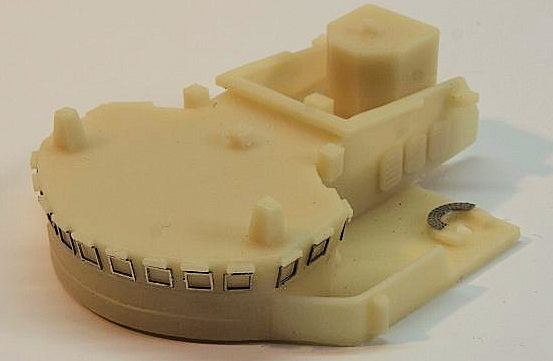 ire.
Iīm always partial to bridge windows. They are the face of the vessel to me, and
need to look good. In this case, they were only lightly marked in the resin
part, and would need a lot of careful masking and painting. To improve that look
a bit, I cut squares from PE ladders of appropriate size, and glued them to the
model as "window frames".
ire.
Iīm always partial to bridge windows. They are the face of the vessel to me, and
need to look good. In this case, they were only lightly marked in the resin
part, and would need a lot of careful masking and painting. To improve that look
a bit, I cut squares from PE ladders of appropriate size, and glued them to the
model as "window frames".
Apart from that, I followed instructions and worked my way through the subassemblies.
In this build, I tried a different approach to the railings. I cut them out of the PE fret, cleaned them up, bent them to shape, and then placed them on mounting blocks. I use blocks of foam board with a budget version of Tamiya tape fixed to them by pins for all my subassemblies, and it worked quite well.
Early on in the project, I made the base for the model in my usual
method from 30 mm foam board. A cutout for the hull was made, and the general
wave pattern produced by gently applying heat from a gas burner. Adequate
ventilation is a must. The model w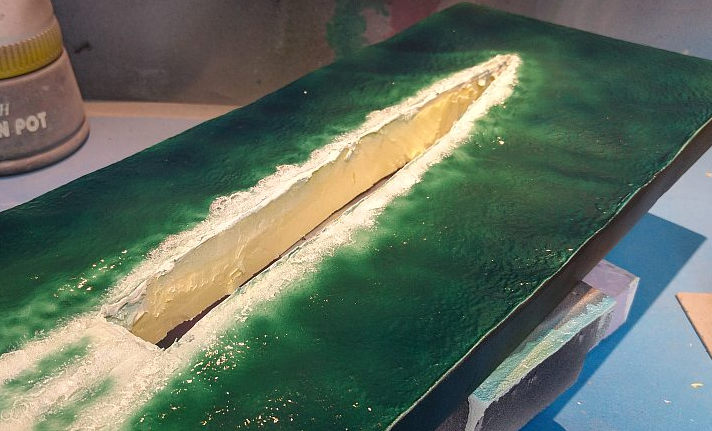 as
isolated using clingfilm, and then placed in the cutout on the base. Remaining
gaps were filled with acrylic caulking. That cured, the model was removed and
the caulking trimmed. The sea surface structure was produced by stippling white
wall paint onto the base. Wave effects were sculpted using heavy gloss clear
acrylic gel. The surface shade was achieved by irregularly spraying first a
green shade away from the ship cutout, and then a blue shade for the further
areas. After all this water-based materials had dried, the base was sprayed with
a solvent-based clear gloss spray from a rattle can to achieve the desired
sheen. Further wave effects were added using acrylic gel, highlighted after
curing with white artistīs oil paint.
as
isolated using clingfilm, and then placed in the cutout on the base. Remaining
gaps were filled with acrylic caulking. That cured, the model was removed and
the caulking trimmed. The sea surface structure was produced by stippling white
wall paint onto the base. Wave effects were sculpted using heavy gloss clear
acrylic gel. The surface shade was achieved by irregularly spraying first a
green shade away from the ship cutout, and then a blue shade for the further
areas. After all this water-based materials had dried, the base was sprayed with
a solvent-based clear gloss spray from a rattle can to achieve the desired
sheen. Further wave effects were added using acrylic gel, highlighted after
curing with white artistīs oil paint.
| COLORS & MARKINGS |
Arrow had a rather simple paint scheme of R.N. Light Weatherwork Grey for her vertical and R.N. Light Deck Grey for her horizontal surfaces. Her boot topping was black, and her lower hull antifouling red. Her hull and flight deck markings had been hastily overpainted upon the begin of hostilities, but on the homecoming image it was evident that this paint was peeling off at the time, revealing her markings again. She had suffered quite some wear and tear, and her hull was rust-streaked.
I started with priming the model using Stynylrez acrylic primer, which in my experience is quite ahead of the acrylic primers I previously used. There was nearly no paint lift off, and the primer can be sanded and "feathered" virtually like ye aulde enamel stuffe. Spraying the lower hull in black primer, I masked off the boot topping and then sprayed the lower hull Vallejo fire red over it. That ended up in a nicely muted brick red.
That also masked, I sprayed the horizontal surfaces in Vallejo ModelAir
Grey Primer, which to me is a good approximation for the RN deck grey. I needed
to do a lot of masking after that, but it was worth it. Having masked all the
decks, I sprayed the vertical surfaces ModelAir Pale Blue Grey aka RLM 76. I
only needed some minor touchups and was quite happy with that. Numerous smaller
deck items were painted by hand, though. The railings were sprayed light grey,
and the bars hand painted dark grey. The bridge windows
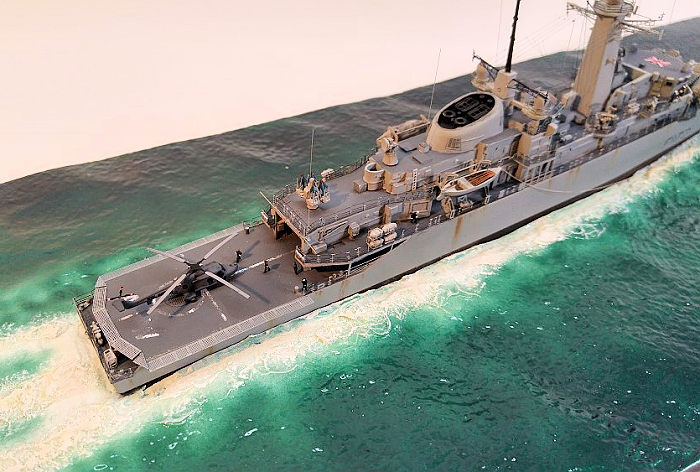 were
painted with thinned dark blue paint at this stage, too.
were
painted with thinned dark blue paint at this stage, too.
Next, the model was glosscoated using Klear, preparatory to decaling. I then applied the kit decals for the hull, transom and flight deck markings, and again glosscoated them.
Now for the interesting part: I applied Marmite, the iconic and tremendously healthy British yeast extract to the markings using a little piece of a sponge. After applying, the surrounding areas were masked and the markings sprayed over with the appropriate paint. After curing, the marmited areas were brushed off and the markings re-appeared in part. Just like the hairspray or salt chipping method, but with a uniquely British touch.
I do not know whether the flight deck markings also re-appeared during the end of the deployment, but I liked dabbling with the Marmite and the effect so much that I did it anyway. I also added a Union Flag decal from my stash to the wheelhouse roof, even though I have no hard evidence that it was there. I know Glamorgan had it, and I consider it quite likely that the Type 21īs had it, too.
Now it was time to bring things together.
| FINAL CONSTRUCTION |
Having added the superstructure blocks and cleaned up the remaining
gaps, I started adding details, always working away from the centre of the model
to its periphery. So I began with the equipment for the topmost deck and the
masts. I also rigged the model at this early stage, as rigging is always my
nightmare and I appreciate having as little risk of accidental damage as
possible. UNI Caenis monofilament was used. Continuing to add my prepared
subassemblies, I arrived at the boats and finally at the flight deck and the
forecastle. Railings were carefully attached with Zap a Gap Medium CA glue,
excesses removed with a Q-tip. Som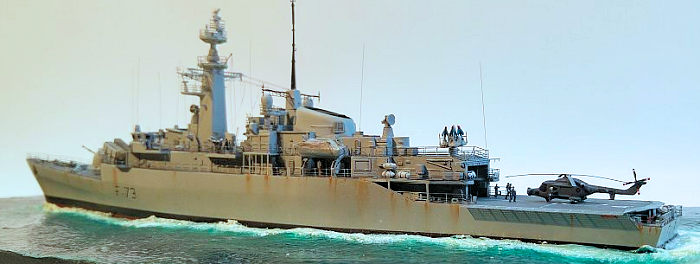 e
paint touchups were needed, but not overly much. Anchor chains and stoppers were
added to the forecastle deck, and the anchors. The helo was built from the box
and placed on the flight deck. A number of sailors from my NorthStar supplies
were placed aboard. An acrylic flat coat was applied to achieve a uniform
surface.
e
paint touchups were needed, but not overly much. Anchor chains and stoppers were
added to the forecastle deck, and the anchors. The helo was built from the box
and placed on the flight deck. A number of sailors from my NorthStar supplies
were placed aboard. An acrylic flat coat was applied to achieve a uniform
surface.
The vessel was weathered with several shades of artistīs oil paints, applied with a toothpick and smeared with a Q-tip. That done, a really final flat coat sealed the model and it was placed onto its base. Any remaining gaps were closed with heavy clear gloss acrylic gel.
| CONCLUSIONS |
This is a good kit, very complete and well produced, that builds into a handsome model of a ship that may not have been the best amongst the RN postwar classes, but performed as well as could be expected and looked good doing so.
| REFERENCES |
Friedman, Norman: British destroyers and frigates. London 2006. Pg. 291-96
Preston, Anthony: The Worldīs worst warships. London 2002. Pg. 171-76
Brown, David K: Rebuilding the Royal Navy. Barnsley 2012. Pg. 103-4
The Type 21 Club Association: https://type21club.org/
2 October 2018
Copyright ModelingMadness.com
If you would like your product reviewed fairly and fairly quickly, please contact the editor or see other details in the Note to Contributors.
Back to the Main Page Back to the Review Index Page Back to the Previews Index Page